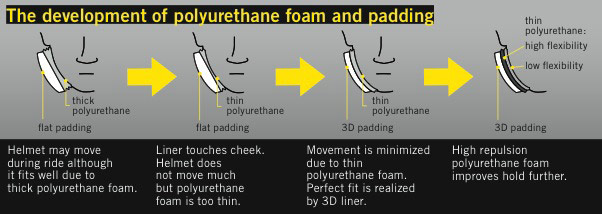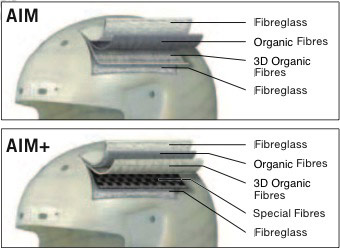WHAT'S IN A SHOEI?
Thanks to decades of experience in helmet technology, millions of riders place their trust in SHOEI. Please browse the sections below to see what goes into each SHOEI. How-to videos on how to care for your SHOEI » are viewable here
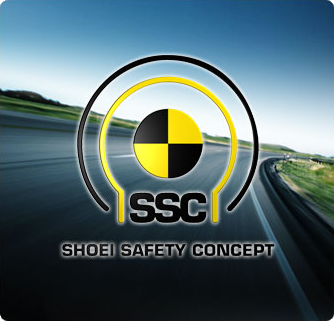
Outstanding comfort
In addition to the basic safety properties that ensure protection in the event of an impact, there are also the comfort aspects that characterise an outstanding helmet. A comfortable helmet makes a decisive contribution to relieving the load on the rider and helps his concentration – an important constituent part of the SHOEI safety concept.
Passive safety / Active safety
Ensuring its helmets comply with the various standards worldwide for passive safety takes top priority at SHOEI. Our strict quality assurance ensures that this applies at all times and for all SHOEI helmets. But our products have also made a number of contributions to active safety. For example, the aerodynamics, the comfortable padding and the efficient ventilation of all our helmets help the rider to concentrate on the one important thing: driving safely.
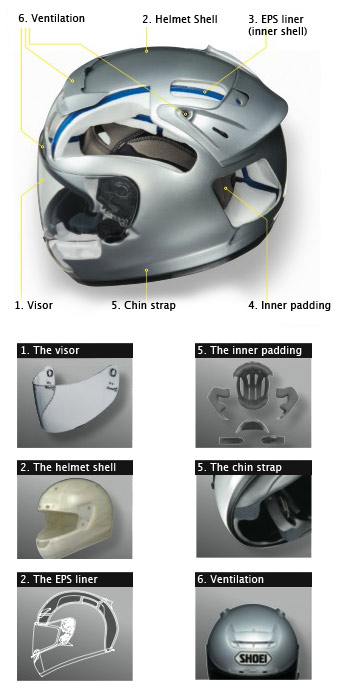
Of all types of helmets, a motorcycle helmet is the one that has to meet the toughest requirements concerning its protective function. Its strong outer shell and its broad impact protection distinguish it fundamentally from other types of helmets.
1. The visor
The visor protects the rider against wind, dirt, insects and UV radiation, but at all times it must also guarantee clear vision without any optical distortion.
2. The helmet shell
The helmet shell absorbs the impact energy in the event of a fall and distributes it over the largest possible area.
3. The EPS liner (inner shell)
The energy that is passed on by the helmet shell is taken up by the shock-absorbing inner shell and ensures a maximum degree of safety. The helmet inner shell consists of light, shock-absorbing polystyrene and is pressed
together in the event of an impact.
4. The inner padding
The inner padding consists of high-quality polyurethane foam of various
levels of hardness with covers of pleasant padding materials and ensures a perfect hold and pleasant seating.
5. The chin strap
The task of the chin strap is to hold the helmet firmly on the head. This is done by using a chin strap whose tensile strength and extensibility are matched especially to this function. The chin strap is firmly attached to the helmet shell by means of metal rivets.
6. Ventilation
The SHOEI ventilation system directs the wind from the speed of travel into the helmet and guides warm and damp air to the outside. Ventilation is one of the elementary and important innovations in the equipment of our more recent models. The perfect placing and shaping of the inlets, outlets and channels is the basis of optimum ventilation and requires a very special know-how.

Meeting and exceeding safety standards
The impact protection for the head is used to provide passive safety is a major constituent part of the SHOEI safety concept. The performance of a helmet with regard to passive safety is measured on the basis of various international safety standards. Thanks to many years of know-how and our commitment to quality assurance, the performance properties of all SHOEI helmets are clearly above the requirements of these standards.
The ECE R22/05 standard
A number of safety standards have established themselves worldwide and they differ markedly from one another concerning their criteria and test scenarios, in accordance with the requirements in the various countries. The ECE R22/05 Directive applies in all the countries of the ECE (Economic Commission for Europe) and those countries that have associated themselves with this standard. Helmets that do not comply with this Directive may not be sold in the relevant countries of the ECE with few exceptions.
The ECE R22/05 standard tests among other things the impact damping, the chin strap, the roll-off behaviour, the structure and the resistance. Two criteria are tested in the impact damping test. On the one hand, the permissible value for the maximum acceleration is measured in g (Peak G) and on the other hand the HIC (Head Injury Criterion), hence the risk of injury for the head. The HIC represents the total amount of energy that acts on the head and is calculated from the impact speed and the length of time that the force acts. The maximum permitted values of 275 g and 2400 for the HIC are handled very strictly in the ECE countries. The special properties of the outer shell, the high shock-absorbing ability of the inner shell and absolute quality assurance ensure that SHOEI meets these stipulations at all times and shows the very best results.
The inner shell of a SHOEI helmet
In accordance with its high level of quality, each SHOEI helmet that is offered for sale in Europe is given a shock-absorbing double inner shell with a special shaping. The combination of the various grades of expanded EPS provides an effective damping of shocks and impacts and at the same time for a low HIC value. The upper part of the helmet inner shell is generally softer than the outer edge. The relatively hard edge of the inner shell increases the damping effect in the event of a crash and provides a low HIC value. The technology has been patented and is regarded as the technical property of SHOEI.

The real life wearing experience
As opposed to “passive safety” that is ensured by compliance with the various country-specific safety standards, “active safety” means an improvement in wearing comfort to allow the rider to devote his full concentration to driving. Product properties such as improved inner padding for optimum seating of the helmet, the lowest possible weight to reduce stress on the neck muscles, an effective ventilation system for temperature regulation and a reduction of wind noises primarily serve the safety of the rider. This underscores the importance of the continuous further development of SHOEI helmets in the area of comfort technology.
The inner padding
The material and the shape of the inner padding are decisive for the wearing comfort and proper fit of the helmet. The wearing comfort covers the effect of the material properties on the skin of the rider. The fit defines how well the helmet sits on the head and stays in place and is especially noticeable at high speeds. In the past these two criteria often worked against one another. Very thick, soft padding provided good wearing comfort, but it did not hold well at high speeds and led to wobbling. SHOEI rethought the structure and function of the inner padding and developed a new concept. The inner shell of the helmet was shaped to the head, and thus, thinner padding can be used. This in turn is produced in a complicated process either from multiple layers of polyurethane foam of different hardnesses or else is cut three-dimensionally from a block so as to ensure optimum hold together with high wearing comfort.
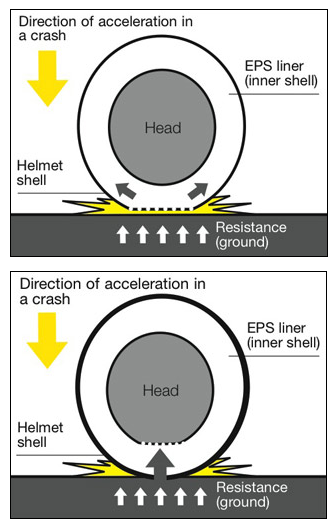
Impact absorbtion
The AIM outer shell from SHOEI primarily offers in addition to its enormous weight advantages the best possible impact protection. Through the interaction of the strength and the elasticity of the various materials, the AIM outer shell has been designed in such a way that the effect of an impact is absorbed as well as is possible and is distributed over the entire shell and inner shell. Thus the outer shell and the inner shell may show damage from deformation after an impact, but the head of the rider is given the maximum amount of protection as a result. Heavy, hard helmet shells do not have this ability and direct the energy from an impact without any reduction into the inside of the helmet. In many cases the shell may be undamaged but it was not possible to avoid head injuries. This applies in particular to helmets that were primarily designed to prevent penetration by sharp objects.
AIM Advanced Integrated Matrix
1. Polyurethane Pad consisting of 3D Cut Polyurethane Foam Shaping process with fibre-reinforced layer matrix. Generally, an outer shell that is made of fibreglass (FRP) is given its shape by a heat-setting plastic. The SHOEI outer shell owes its ideal function to the integration of organic fibres and of three-dimensional shaping in a layered structure. This produces a helmet outer shell that is characterised by high strength for a very low weight as compared to shells that are produced in a conventional way.
2. The compound structure. The AIM shell consists of various layers of reinforcing organic fibres and glass fibres. Compared to an outer shell that is only made of glass fibres, the AIM outer shell is both lighter and more elastic for the same strength, and the AIM+ outer shell is even lighter due to the additional use of special fibres.
3. The synthetic resin. A specially modified, unsaturated polyester resin, a so-called heat-setting plastic, is used for the AIM outer shell. This resin acquires the desired strength and elasticity during the heat hardening process. This synthetic resin is also extremely resistant to corrosion for good measure.
With these constituent parts we produce outer shells that convincingly produce ideal damping of impacts, good elasticity, light weight and enormously high strength.
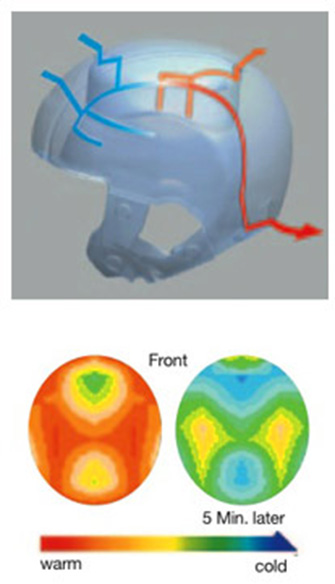
Optimum air intake
Back in the early 1980s SHOEI developed a ventilation system that passed air through holes in the helmet shell without affecting the stability of the outer shell. The idea that good ventilation is crucial for the safety of a helmet caused a fundamental change in the design of motorcycle helmets. This once again makes it clear how important the safety concepts and a spirit of innovation are at SHOEI. The investment in a wind tunnel of our own allows us to carry out intensive studies in the development of effective and high-performance ventilation systems.
SHOEI has developed a dual EPS liner (inner shell) whose air system allows an optimum exchange of warm, used air and incoming cold fresh air.
Improving the aerodynamics
The stress applied to the neck muscles when riding a motorcycle comes not only from the weight of the helmet itself but also, above all, from the air resistance. For that reason improving the aerodynamics is an important factor in preventing the onset of tiredness. The SHOEI product development section regularly makes tests in its own wind tunnel to design helmets with optimum aerodynamic properties.
The SHOEI visor system
The visor protects the rider against wind, dirt and insects. In addition to full face helmets, many open helmets and half helmets are also provided with a visor. All SHOEI visors are made of polycarbonate. Most of them are produced by the so-called injection moulding process. This guarantees clear and distortion-free vision.

Furthermore, the visor protects against small stones and absorbs 99% of the UV radiation, its coating prevents scratches and lets water roll off more easily in beads. Except the Hornet-DS model all visors are provided with SHOEI’s own Q.R.B.P. system and thus allow the visor to be changed quickly and easily without needing any extra tools. The smooth surface of a SHOEI visor comes without an irritating visor cover and so prevents unnecessary wind noise.

Noise Exposure
Polyurethane Pad consisting of 3D Cut Polyurethane Foam A high level of noise imposes unnecessary stress on the rider and disturbs his concentration. There are two ways to reduce noise in the helmet through suitable design. On the one hand, wind noise can be reduced by optimising the aerodynamics. On the other hand, the acoustic damping properties of the helmet can be optimised by suitable design of the helmet shell and the padding. The decisive factor for a comfortable and quiet helmet is the balanced utilization of these two approaches. Reducing the noise through a thicker helmet shell, doing without ventilation or using padding that is too tight may reduce the amount of noise experienced, but this is achieved at the expense of safety and comfort and hence is not an option for SHOEI.

Tests in the wind tunnel
 All SHOEI helmets are developed from the three points of view of safety, comfort and passion. Information gained from all over the world goes into the development.
All SHOEI helmets are developed from the three points of view of safety, comfort and passion. Information gained from all over the world goes into the development.
More than 20 years ago SHOEI was the first maker to recognise the importance of aerodynamics for a helmet. In the meantime SHOEI has a wind tunnel of its own that is an indispensable constituent part of product development. In addition to the effects of air resistance and the various forces applied, tests are constantly made of the performance of the ventilation and how noise is produced.
Test drives
Intensive test drives are done in addition to verify the results of the wind tunnel testing. For example, the various forms of air flow for different types of motorcycles or comfort on longstretches are investigated and taken into consideration when developing a helmet design.
Racing service
Nowhere are the requirements placed on a helmet more extreme than in professional racing sport. The development of SHOEI sports helmets is decisively supported by our factory riders in the MotoGP and other international classes. Among other things, the ventilation system and the quick-change visor system were developed first for racing sport. Today every rider with a SHOEI helmet can benefit from these technologies.
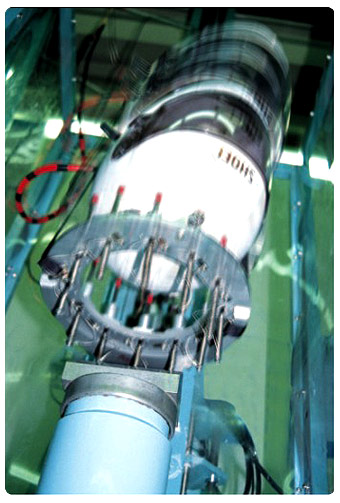
Production & Quality Assurance
For all the energy and passion that are invested in the development of a product, in the last resort the quality in series production must comply with the specifications from the development section. The following explains on the basis of the manufacturing process what it is that makes up the unique quality of SHOEI helmets.
Production of the helmet shell
SHOEI exclusively uses fibre-reinforced plastics that offer the best properties for the manufacture of a helmet shell. Thanks to having many years of experience and highly specialised employees, SHOEI is in a position to produce helmet shells that are extremely strong and yet light. Each helmet shell is marked personally by the employee who is responsible for it and thus puts his name on the line for the quality of this example.
Painting
Even though many production steps have been automated today, it is not possible to dispense with hand work in some areas. SHOEI combines hand work and automation in production to ensure superlative quality.
Final assembly
The ventilation sliders, visor seals, inner shell and padding are assembled with great care. The helmet only goes for sale after the subsequent detailed final inspection. This strict compliance with the production processes with associated quality control guarantees the constantly high SHOEI quality.
Quality control in the development stage
Each helmet that leaves our factories in Ibaraki und Iwate had first been subjected to
intensive quality control.
The country-specific safety standards play a major role during the development of a helmet. The helmet shell and the shock-absorbing inner shell are continuously tested for hardness and elasticity and modified as required. This results in a helmet that meets the strict standards that are applied and nonetheless still combines all the advantages of the original design in itself.
Quality control during production
Strict quality control tales places at SHOEI in all phases of production. From manufacturer of the outer shell up to final assembly. In addition to that, samples are regularly taken from normal production and tested at the company’s own test facilities. Every year more than 3,000 helmets are tested to ensure perfect safety and destroyed in doing so. These test helmets thus make a major contribution to the safety of our products.

